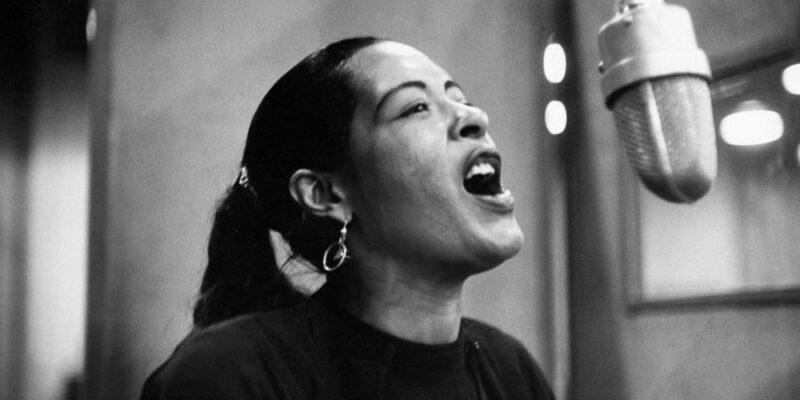What was Billie Holiday’s Net Worth?
Billie Holiday was an American jazz and swing singer who had a net worth of $750 at the time of her death in 1959. Despite being extremely successful during her career, unfortunately, in her final years Billie was swindled by a series of romantic partners. When she died, Billie had just 70 cents in her bank account and $750 in cash taped to her leg.
Billy Holiday enjoyed mainstream success as a recording artist in the 1930s and ’40s. Her hit songs include “What a Little Moonlight Can Do,” “I’ve Got My Love to Keep Me Warm,” “Strange Fruit,” “God Bless the Child,” and “Trav’lin’ Light.” After going through drug and legal troubles and serving a short prison sentence, Holiday became a successful concert performer in the 1950s before passing away nearly penniless at the end of the decade.
Early Life
Billie Holiday was born as Eleanora Fagan on April 7, 1915 in Philadelphia, Pennsylvania to teenage parents Sarah and Clarence. Not long after, her father left the family to pursue a career as a jazz musician. Holiday was raised by her aunt Eva Miller, and Miller’s mother-in-law Martha, in Baltimore, Maryland. Often skipping school as a youth, Holiday was brought before a juvenile court at the age of nine. She was subsequently sent to a Catholic girls’ reform school, where the nuns punished her by locking her in a room overnight with a dead girl. Holiday was released from the school after nine months. She went on to work with her mother at a restaurant her mother had opened.
On Christmas Eve in 1926, Holiday survived an attempted rape by a neighbor, who was arrested. She was then sent back to the Catholic reform school she had previously attended, this time under protective custody. After her release in early 1927, Holiday found work running errands in a brothel and cleaning homes in her neighborhood. In 1929, she moved to Harlem, where her mother was living.
Career in the 1930s
In Harlem, Holiday began singing in nightclubs. She partnered with her neighbor Kenneth Hollan, a saxophonist, from 1929 to 1931. Holiday got her big break in 1933 when she was spotted by record producer John Hammond Jr. at the club Covan’s. She went on to make her recording debut with the songs “Your Mother’s Son-in-Law” and “Riffin’ the Scotch,” recorded with Benny Goodman and his orchestra. In 1935, Holiday made her screen debut in the musical short film “Symphony in Black: A Rhapsody of Negro Life.” Also that year, she was signed to Brunswick Records to record songs with pianist Teddy Wilson and his band, resulting in their hit version of “What a Little Moonlight Can Do.” Holiday and Wilson had further hits with their recordings of such songs as “I Cried for You” and “Easy Living.”
In 1937, Holiday released her hit recording of “I’ve Got My Love to Keep Me Warm.” She also became a big-band vocalist on the road with Count Basie. However, she was fired in early 1938. After leaving Count Basie’s band, Holiday joined Artie Shaw’s band, making her one of the first black women to work with a white orchestra. With Shaw and his band, she was broadcast on the major New York City radio station WABC. The partnership didn’t last long, however, as Holiday soon quit the band due to racism she faced at the venues where she performed. Toward the end of 1938, she had a hit with her song “I’m Gonna Lock My Heart (And Throw Away the Key).” Holiday went on to record one of her signature songs in 1939: “Strange Fruit.” The lynching protest song, based on a poem by Abel Meeropol, became Holiday’s biggest-selling record.
(Photo by Michael Ochs Archives/Getty Images)
Career in the 1940s
In the early 1940s, Holiday scored one of her greatest hits with the song “God Bless the Child,” which she co-wrote with Arthur Herzog Jr. She also had a huge hit with “Trav’lin’ Light,” which she recorded with Paul Whiteman and his band. In 1944, Holiday signed to Decca Records, and in 1945 she scored a major hit for the label with her version of the song “Lover Man (Oh, Where Can You Be?).” The B-side of the song was “That Ole Devil Called Love.” Holiday went on to record such songs as “Don’t Explain,” “What is This Thing Called Love?,” and “Good Morning Heartache.” In 1947, she appeared in her only major motion picture, the musical romance “New Orleans,” in which she appears alongside Louis Armstrong.
Although Holiday had reached her commercial zenith by 1947, she was also plagued by substance abuse problems. That spring, she was arrested in her New York apartment for possession of narcotics. Refused a lawyer and suffering from dehydration at her trial, Holiday pleaded guilty and was sentenced to prison. She was ultimately released early, in March of 1948, on account of good behavior. Holiday went on to mount a major comeback later in the month at Carnegie Hall, where she performed to a sold-out audience. She continued her comeback in April as the star of the sold-out Broadway show “Holiday on Broadway.” However, Holiday was arrested again in early 1949. Later that year, she recorded “Crazy He Calls Me.”
Career in the 1950s
Holiday experienced a career decline in the 1950s due to economic woes and deteriorating health brought upon by heavy drug use and relationships with abusive men. However, she did a number of successful concerts during the decade, including two sold-out shows at Carnegie Hall in 1956. Also that year, Holiday released her autobiography “Lady Sings the Blues,” as well as an album of the same name featuring four new songs. The autobiography was later adapted into a film starring Diana Ross as Holiday. In 1958, Holiday released the album “Lady in Satin”; it was followed in 1959 by “Last Recording,” which was released just after her passing.
Personal Life and Death
Holiday married her first husband, trombonist Jimmy Monroe, in 1941. Both were unfaithful, with Holiday having an affair with her drug dealer Joe Guy during the marriage. She divorced Monroe in 1947, and in 1951 married Guy. Holiday’s second marriage also ended in divorce, in 1957. She subsequently wed mob enforcer Louis McKay, who was abusive toward her like most of the other men in her life, and swindled her out of her earnings.
In the late 1950s, Holiday was diagnosed with cirrhosis of the liver. She was taken to the hospital in the spring of 1959 and was treated for both liver and heart disease. While in the hospital, police placed Holiday under house arrest for narcotics possession. On July 17, 1959, she passed away from complications of liver disease. Holiday was buried at Saint Raymond’s Cemetery in the Bronx.
All net worths are calculated using data drawn from public sources. When provided, we also incorporate private tips and feedback received from the celebrities or their representatives. While we work diligently to ensure that our numbers are as accurate as possible, unless otherwise indicated they are only estimates. We welcome all corrections and feedback using the button below.











Comments